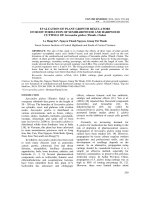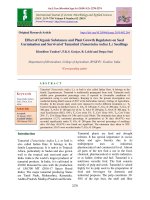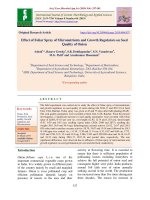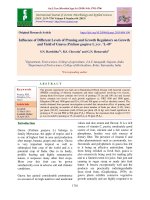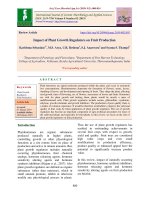Effects of some growth regulators on tissue culture of hardy chrysanthemums (chryssanthemmum x koreanum)
Bạn đang xem bản rút gọn của tài liệu. Xem và tải ngay bản đầy đủ của tài liệu tại đây (2.52 MB, 92 trang )
VIETNAM NATIONAL UNIVERSITY OF AGRICULTURE
FACULTY OF AGRONOMY
UNDERGRADUATE THESIS
TOPIC: EFFECTS OF SOME GROWTH
REGULATORS ON TISSUE CULTURE OF HARDY
CHRYSANTHEMUMS (Chrysanthemum × koreanum)
Instructor:
Dr. Pham Phu Long
Department:
Botany
Student:
Le Mai Anh
Class:
K61KHCTT
Student ID:
611753
HA NOI – 2020
COMMITMENT
I hereby declare that the data and research results in the undergraduate
thesis "Effects of some growth regulators on tissue culture of hardy
chrysanthemums (Chrysanthemum × koreanum)" are honest without being
copied or used in any other research. All references are fully cited and traced. I
take full responsibility to the department, faculty, and the university for this
commitment.
i
ACKNOWLEDGE
In order to finish this thesis, I would like to sincerely thank to:
- The Faculty of Agronomy of Vietnam National University of Agriculture
for creating the most favorable conditions for me to work on the thesis.
- Dr. Pham Phu Long for his direct guidance to me.
- Dr. Phung Thi Thu Ha and my fellow at the Lab of Plant
Biotechnological Applications for supporting me on this thesis.
- Teachers of Vietnam National University of Agriculture for teaching and
imparting valuable knowledge as the foundation for me to complete this thesis.
Hanoi, February 2021
Sincerely,
ii
LIST OF CONTENTS
COMMITMENT .......................................................................................................... i
ACKNOWLEDGE ......................................................................................................ii
LIST OF CONTENTS ............................................................................................... iii
LIST OF TABLES....................................................................................................... v
LIST OF FIGURES ...................................................................................................vii
LIST OF ACRONYMS ............................................................................................viii
ABSTRACT ............................................................................................................... ix
PART I. INTRODUCTION ......................................................................................... 1
1.1. Introduction .......................................................................................................... 1
1.2. Objective and scope of study................................................................................. 2
1.2.1. Objective............................................................................................................ 2
1.2.2. Scope of study.................................................................................................... 2
PART II. LITERATURE REVIEWS ........................................................................... 3
2.1. General introduction of chrysanthemum ............................................................... 3
2.1.1. Origin and classification..................................................................................... 3
2.1.2. Botanical characteristics .................................................................................... 4
2.1.3. Values and benefits ............................................................................................ 5
2.2. Chrysanthemum production and cultivation techniques ......................................... 6
2.2.1. Chrysanthemum production in the world............................................................ 6
2.2.2. Chrysanthemum production in Vietnam ............................................................. 7
2.2.3. Chrysanthemum cultivation techniques .............................................................. 9
2.3. The scientific basis of tissue culture .................................................................... 11
2.3.1. Scientific basis of plant cell culture .................................................................. 11
2.3.2. Plant cell culture techniques ............................................................................. 12
2.3.3. Culture medium ............................................................................................... 12
2.4. Research situation in the world and Vietnam....................................................... 13
2.4.1. Research situation in the world ........................................................................ 13
2.4.2. Research situation in Vietnam .......................................................................... 16
PART III. MATERIAL AND METHOD ................................................................... 19
3.1. Plant material ...................................................................................................... 19
3.2. Time and location ............................................................................................... 19
iii
3.3. Researching contents........................................................................................... 19
3.3.1. Evaluating the callus formation ........................................................................ 19
3.3.2. Evaluating the rapid multiplication................................................................... 22
3.3.3. Evaluating the shoot regeneration .................................................................... 24
3.3.4. Evaluating the shoot growth ............................................................................. 26
3.3.5. Evaluating the root formation ........................................................................... 27
3.4. Researching method ............................................................................................ 28
3.4.1. Sample sterilization .......................................................................................... 28
3.4.2. Experiment design ........................................................................................... 28
3.4.3. Parameters ....................................................................................................... 28
3.4.4. Data processing ................................................................................................ 29
PART IV: RESULTS AND DISCUSSION ............................................................... 30
4.1. Striped Dwarf variety .......................................................................................... 30
4.1.1. Evaluating the callus formation ........................................................................ 30
4.1.2. Evaluating the rapid multiplication................................................................... 34
4.1.3. Evaluating the shoot regeneration .................................................................... 37
4.1.4. Evaluating the shoot growth ............................................................................. 39
4.1.5. Evaluating the root formation ........................................................................... 40
4.2. Yellow Dwarf variety.......................................................................................... 42
4.2.1. Evaluating the callus formation ........................................................................ 42
4.2.2. Evaluating the rapid multiplication................................................................... 45
4.2.3. Evaluating the shoot regeneration .................................................................... 48
4.2.4. Evaluating the shoot growth ............................................................................. 49
4.2.5. Evaluating the root formation ........................................................................... 50
PART V. CONCLUSION AND RECOMMENDATION .......................................... 53
5.1. Conclusion .......................................................................................................... 53
5.2. Recommendation ................................................................................................ 54
REFERENCES .......................................................................................................... 55
DATA ANALYSIS ................................................................................................... 57
iv
LIST OF TABLES
Table 3.1. Treatment of experiment on the effect of 6-BA on callus formation in
Striped Dwarf variety................................................................................................. 19
Table 3.2. Treatment of experiment on the effect of 2,4-D on callus formation in
Striped Dwarf variety................................................................................................. 20
Table 3.3. Treatment of experiment on the effect of 6-BA on callus formation in
Yellow Dwarf variety ................................................................................................ 21
Table 3.4. Treatment of experiment on the effect of 2,4-D on callus formation in
Yellow Dwarf variety ................................................................................................ 21
Table 3.5. Treatment of experiment on the effect of 6-BA on rapid multiplication in
Striped Dwarf variety................................................................................................. 22
Table 3.6. Treatment of experiment on the effect of 2,4-D on rapid multiplication in
Striped Dwarf variety................................................................................................. 23
Table 3.7. Treatment of experiment on the effect of 6-BA on rapid multiplication in
Yellow Dwarf variety ................................................................................................ 23
Table 3.8. Treatment of experiment on the effect of 2,4-D on rapid multiplication in
Yellow Dwarf variety ................................................................................................ 24
Table 3.9. Treatment of experiment on the effect of 6-BA on shoot regeneration in
Striped Dwarf variety................................................................................................. 25
Table 3.10. Treatment of experiment on the effect of 6-BA on shoot regeneration in
Yellow Dwarf variety ................................................................................................ 25
Table 3.11. Treatment of experiment on the effect of 6-BA on shoot growth ............. 26
in Striped Dwarf variety............................................................................................. 26
Table 3.12. Treatment of experiment on the effect of 6-BA on shoot growth ............. 27
in Yellow Dwarf variety ............................................................................................ 27
Table 3.13. Treatment of experiment on the effect of NAA on root formation in
Striped Dwarf variety................................................................................................. 27
Table 3.14. Treatment of experiment on the effect of NAA on root formation in
Yellow Dwarf variety ................................................................................................ 28
Table 4.1. Effect of 6-BA on callus formation in Striped Dwarf variety after 4 weeks30
Table 4.2. Effect of 2,4-D on callus formation in Striped Dwarf variety after 4 weeks .... 32
v
Table 4.3. Effect of 6-BA on rapid multiplication in Striped Dwarf variety after 4
weeks ......................................................................................................................... 34
Table 4.4. Effect of 2,4-D on rapid multiplication in Striped Dwarf variety after 4
weeks ......................................................................................................................... 36
Table 4.5. Effect of 6-BA on shoot regeneration in Striped Dwarf variety after 4 weeks . 38
Table 4.6. Effect of 6-BA on shoot growth in Striped Dwarf variety after 4 weeks .... 39
Table 4.7. Effect of NAA on root formation in Striped Dwarf variety after 2 weeks .. 41
Table 4.8. Effect of 6-BA on callus formation in Yellow Dwarf variety after 4 weeks .... 43
Table 4.9. Effect of 2,4-D on callus formation in Yellow Dwarf variety after 4 weeks .... 44
Table 4.10. Effect of 6-BA on rapid multiplication in Yellow Dwarf variety after 4
weeks ......................................................................................................................... 45
Table 4.11. Effect of 2,4-D on rapid multiplication in Yellow Dwarf variety after 4
weeks ......................................................................................................................... 46
Table 4.12. Effect of 6-BA on shoot regeneration in Yellow Dwarf variety after 4
weeks ......................................................................................................................... 48
Table 4.13. Effect of 6-BA on shoot growth in Yellow Dwarf variety after 4 weeks .. 50
Table 4.14. Effect of NAA on root formation in Yellow Dwarf variety after 2 weeks 51
vi
LIST OF FIGURES
Figure 4.1. Striped Dwarf variety’s callus after 4 weeks of callus formation stage in 6BA 1.5 ml/l medium .................................................................................................. 34
Figure 4.2. Striped Dwarf variety’s callus after 4 weeks of rapid multiplication stage in
6-BA 1.5 ml/l medium ............................................................................................... 37
Figure 4.3. Striped Dwarf variety’s regenerated shoot from callus after 4 weeks of
shoot regeneration stage in 6-BA 1.0 ml/l medium .................................................... 39
Figure 4.4. Striped Dwarf variety’s shoot after 4 weeks of shoot growth stage in 6-BA
1.0 ml/l medium......................................................................................................... 40
Figure 4.5. Striped Dwarf variety’s complete plant after 2 weeks of root formation
stage in NAA 2.0 ml/l medium .................................................................................. 42
Figure 4.6. Yellow Dwarf variety’s callus after 4 weeks of rapid multiplication stage in
6-BA 1.5 ml/l medium ............................................................................................... 47
Figure 4.7. Yellow Dwarf variety’s regenerated shoot from callus after 4 weeks of
shoot regeneration stage in 6-BA 1.0 ml/l medium .................................................... 49
Figure 4.8. Yellow Dwarf variety’s complete plant after 2 weeks of root formation
stage in NAA 2.0 ml/l medium .................................................................................. 52
vii
LIST OF ACRONYMS
6-BA/BA:
6-Benzylaminopurine
NAA:
1-Naphthaleneacetic acid
2,4-D:
2,4-Dichlorophenoxyacetic acid
IAA:
Indole-3-acetic acid
IBA:
Indole-3-butyric acid
MS:
Murashige and Skoog
mg/l:
milligram/liter
g/l:
gram/liter
g:
gram
kg:
kilogram
m:
meter
cm:
centimeter
Co:
coconut water
AC:
active charcoal
conc:
concentration
viii
ABSTRACT
This study aimed to evaluate the effects of some growth regulators on in
vitro propagation method of two varieties of hardy chrysanthemums
(Chrysanthemum × koreanum) and figure out the optimal medium for in vitro
propagation of two varieties of hardy chrysanthemums. Plant materials included
two varieties of Chrysanthemum × koreanum. Experiment design was a
complete randomized design was employed in all experiments with 3 times
replication. After collecting the experimental results, the optimal composition of
the tissue culture medium to achieve the best results of the two chrysanthemum
varieties was determined. For Striped Dwarf variety: The optimal medium for
callus formation is 1/2 MS + 6-BA 1.5 ml/l + NAA 0.5 ml/l + sucrose 30 g/l +
agar 6 g/l + Co 150 ml/l, pH = 5.7, with the largest callus mass of 127.96 ± 5.76
mg; The optimal medium for rapid multiplication is 1/2 MS + 6-BA 1.5 ml/l +
NAA 0.5 ml/l + sucrose 30 g/l + agar 6 g/l + Co 150 ml/l, pH = 5.7, with
maximum multiplier of 13.74 ± 0.60 times; The optimal medium for shoot
regeneration is 1/2 MS + 6-BA 1.0 ml/l + NAA 0.5 ml/l + sucrose 30 g/l + agar
6 g/l + Co 150 ml/l, pH = 5.7, with the optimal number of shoot per callus was
8.90 ± 0.81 shoots; The optimal medium for shoot growth is MS + 6-BA 0.5
ml/l + NAA 0.5 ml/l + sucrose 30 g/l + agar 6 g/l, pH = 5.7, with the maximum
height increase of 2.19 ± 0.14 cm; The optimal medium for root formation is MS
+ 6-BA 1.0ml/l + NAA 2.0 ml/l + sucrose 30 g/l + agar 6 g/l + AC 0.2 g/l, pH =
5.7, with a root number of 10.11 ± 0.17. For Yellow Dwarf variety: The optimal
medium for callus formation is 1/2 MS+ 6-BA 1.5 ml/l + NAA 0.5 ml/l +
sucrose 30 g/l + agar 6 g/l + Co 150 ml/l, pH = 5.7, with the largest callus mass
of 110.93 ± 1.71 mg; The optimal medium for rapid multiplication is 1/2 MS +
6-BA 1.5 ml/l + NAA 0.5 ml/l + sucrose 30 g/l + agar 6 g/l + Co 150 ml/l, pH =
5.7, with maximum multiplier of 7.97 ± 0.23 times; The optimal medium for
shoot regeneration is 1/2 MS + 6-BA 1.0 ml/l + NAA 0.5 ml/l + sucrose 30 g/l
+ agar 6 g/l + Co 150 ml/l, pH = 5.7, with the optimal number shoot per callus
was 6.93 ± 0.28 shoots; The optimal medium for shoot growth is MS + 6-BA 0.5
ix
ml/l + NAA 0.5 ml/l + sucrose 30 g/l + agar 6 g/l, pH = 5.7, with the maximum
height increase of 1.99 ± 0.05 cm; The optimal medium for root formation is MS
+ 6-BA 1.0ml/l + NAA 2.0 ml/l + sucrose 30 g/l + agar 6 g/l + AC 0.2 g/l, pH =
5.7, with a root number of 8.90 ± 0.18.
x
PART I. INTRODUCTION
1.1. Introduction
Flowers' importance in nature is everywhere - they can feed insects,
birds, animals, and humans; provide natural medicines for humans and some
animals; and aid in a plant's reproduction. For many centuries flowers occupied
an important place in human life. Flowers are an indispensable product, bringing
both spiritual value and great economic value. Since ancient times, people have
had the need to use flowers for decoration and food. Today, with the
development of society, the demand for flowers is increasing. That is why
flower production has become a lucrative part of agriculture. The worldwide
market for flower and ornamental plants is expected to grow roughly 6.3% over
the next five years, reaching $57.4 billion in 2024, up from $42.4 billion in
2019.
Chrysanthemum is one of the five most popular cut flowers in the world.
Chrysanthemum attracts consumers with its abundance of colors: white, yellow,
green, red, purple, orange, etc. Besides, the flower shape and size are also very
diverse; along with the ability to control flowering all year round, they are the
reasons why chrysanthemum the second most consumed flower in the world
market (after rose) (Dang Ngoc Chi, 2006). Chrysanthemum in Vietnam is
widely used for its beauty and durability, and also because of Vietnamese
customs and habits, using the white and yellow varieties as a symbol of grief.
Chrysanthemum can also be used as medicinal herbs. It is used in tea
production, functional foods production, and many other products. Because of
these spiritual values and health benefits, chrysanthemum is popular with
consumers, so the demand for chrysanthemum is always high.
Currently in Vietnam, chrysanthemum is grown all over the country.
There are some specialized cultivation areas such as Da Lat, Ha Noi, and Quang
Ninh with many different varieties. Among the chrysanthemum varieties, hardy
chrysanthemums are very popular for ornamental or decorative purposes, so the
demand for healthy seedlings, disease-free, good resistance to pests and
1
diseases, and adverse environmental conditions with competitive prices is very
high. However, with traditional propagation methods such as sowing seeds,
cutting branches, or taking young shoots from mother plants, the propagation
coefficient is not high: the quality of seedlings is not uniform, the growth time is
long and it is difficult to control the quality of the products. To overcome these
shortcomings, in vitro culture methods and growth regulators are used to create
a very large number of disease-free, healthy seedlings to reduce production
costs. Several growth regulators are used widely in tissue culture but can be
toxic to plants at inappropriate concentrations. Besides, how to use growth
regulators to reduce production costs to the lowest while ensuring the optimal
amount of healthy and qualified products is still a problem.
In summary, under the direct guidance of Dr. Pham Phu Long, the topic
"Effects of some growth regulators on tissue culture of hardy chrysanthemums
(Chrysanthemum × koreanum)" is conducted to research on the optimal culture
medium for hardy chrysanthemums.
1.2. Objective and scope of study
1.2.1. Objective
Evaluating the effects of some growth regulators on in vitro propagation
method of two varieties of hardy chrysanthemums (Chrysanthemum ×
koreanum).
Choosing the optimal medium for in vitro propagation of two varieties
of hardy chrysanthemums.
1.2.2. Scope of study
Determining the suitable media for callus formation from the stem.
Determining the suitable media for multiplication of callus.
Determining the suitable media for shoot regeneration from callus.
Determining the suitable media for shoot development.
Determining the suitable media for root formation.
2
PART II. LITERATURE REVIEWS
2.1. General introduction of chrysanthemum
2.1.1. Origin and classification
The scientific name Chrysanthemum is defined from Greek words “Chiysos”
(yellow) and “themum” (flower). Chrysanthemum is native to China, Japan, and
some European countries. Originated from some wild species of Dendranthema, the
chrysanthemum was grown in China 3000 years ago. Undergone the process of
cultivating, breeding and selecting, it has become modern varieties (Dao Thanh Van
and Dang Thi To Nga, 2007). Chrysanthemum is proved to be used in celebrations
and they appear in ancient paintings and sculptures. From the 1930s, the cultivation
of chrysanthemums was appreciated. In 1982, China held its first chrysanthemum
exhibition in Shanghai with more than one thousand varieties of chrysanthemum,
marking an important milestone in chrysanthemum cultivation. In the following
years, Chinese scientists collected photographic descriptions of thousands of
varieties and continued to hold exhibitions of chrysanthemums. In Japan,
chrysanthemum is brought from China, it is highly appreciated and is often used in
important ceremonies. In 1843, British botanist Fortune brought from China the
Chusan variety. In 1889 Edsmit succeeded in breeding many varieties of
chrysanthemum and he named more than 100 varieties of chrysanthemums of
subsequent generations, some are still maintained and cultivated today. In 1789,
France imported 3 varieties of chrysanthemum from China. Until 1927, Bemct
succeeded in breeding new chrysanthemum varieties, leading to a strong
improvement of chrysanthemum varieties in Europe (Dang Van Dong, 2004). In
America, chrysanthemum has been grown widely since the early eighteenth century.
In Vietnam, the chrysanthemum was imported in the fifteenth century. Vietnamese
people consider chrysanthemum to be a symbol of nobility. It is one of four species
classified as the precious quartet (Truong Huu Tuyen, 1979).
Chrysanthemum is a eudicot that belongs to Plantae kingdom, Magnoliophyta
phylum, Magnoliopsida class, Asterales order, Asteraceae family, Chrysanthemum
genus. The Asterales order has only one family, the Asteraceae, which includes
3
nearly 1000 genera and 20,000 species. They distribute widely on the land, survive in
many different climates and soils. The genus Chrysanthemum is commonly grown as
a potted flower or cut flower all over the world with diverse colors, shapes and sizes.
2.1.2. Botanical characteristics
Chrysanthemum has fibrous roots, shallow roots grow horizontally. Many
secondary roots and root hairs creating a large root system, so the ability to
absorb water and nutrients is strong. These roots grow at the base of the stem, in
parts close to the ground (Nguyen Xuan Linh, 1998).
Chrysanthemum stem is herbaceous with strong branching ability, the
height of the plant depends on variety characteristics and light. Plant height,
degree of branching, softness of stem depend greatly on the genetics of the
variety. The height of chrysanthemum plant depends largely on the genetics of
the variety. The lowest variety is only 20 - 30cm high, while the highest one can
be over 3m high. The short varieties with many branches are suitable for
planting in pots or growing flower beds. The long stem varieties, often with low
branching ability are suitable for planting on the ground for cut flowers or on
high trusses. The variety with many branches, small and soft branches that are
suitable for bonsai growing (Van Ruiten et al., 1984).
Chrysanthemum leaves are simple leaves, lobed, large and deep serrated,
the lower leaf surface is covered with a soft fuzz layer, the upper surface is
smooth, and the veins are palmate. Leaves are flat and thin, maybe slightly tilted
upwards or slightly folded. The closer to the base, the smaller the leaf. The leaf
arrangement is alternate. Leaf sizes usually vary according to the external
conditions and growing techniques. Poorly growing plants have small, thin, hard
leaves that oblique slightly upwards, with a light green or yellowish color.
Healthy plants have large and soft leaves, thick leaf blades, slightly curved
downwards leaf tips with dark green color. Chrysanthemum leaves usually live
for 70 - 90 days, the photosynthetic efficiency of the leaves is strongest in the
fourth leaf from the top. Each leaf axillary usually produces a bud (Cockshull,
1972).
4
The flower shape of Asteraceae family is very specific. The inflorescence
is radially symmetrical, which is very typical, the main axis of the cluster
expands into a flat or convex disc, on which there are no-peduncle, tightly
arranged flowers, the leaves are arranged around outside of the inflorescence,
the whole cluster is shaped like a flower (Dang Van Dong, 2005). Flowers
diameter varies in the range from 1.5 to 12cm. Chrysanthemum flowers are
plentiful in colors: white, yellow, orange, purple, etc. Usually, there are many
flowers on a stem, which grow from the axillaries. Chrysanthemum often cannot
pollinate within flower. In order to get seeds, conducting artificial pollination is
necessary (Vo Van Chi, Duong Duc Tien, 1988). Based on the arrangement of
petals, chrysanthemum flower can be divided into two forms: single flower and
complex flower.
The Chrysanthemum fruit is very small, each fruit contains only 1 seed.
The fruit is dry, brown with a spherical shape. The weight of a thousand seeds is
about 1g (Dang Van Dong, 2005). The Chrysanthemum seed has an embryo and
no endosperm (Le Kim Bien, 1984).
2.1.3. Values and benefits
Chrysanthemum is one of the precious quartet (Tung, Cuc, Truc, Mai),
which is considered as the four precious ornamental plants of Eastern culture
and carries many different meanings. In China, the meaning of the
chrysanthemum is a symbol of longevity. In Japan, the chrysanthemum is a
symbol of wealth, luxury, and nobility. And in Vietnam, the chrysanthemum is
associated with filial piety and love of children to parents. Depends on the color,
chrysanthemum also symbolizes nobility, honesty, love, joy, optimism,
cheerfulness or nostalgia. The chrysanthemum flower shape is beautiful, the
fragrance is gentle and discreet, so chrysanthemums are used a lot to make
flower vases in decoration and make gifts. Chrysanthemums are often placed in
the house on the Tet holiday because chrysanthemum is the symbol of eternity.
According to feng shui, chrysanthemum also brings the family fortune as well as
joy in the new year. Small pots or vases of chrysanthemum can help stabilize
5
your home's well-being. Besides, many species of chrysanthemum are medicinal
materials for the production of functional foods that help improve human health.
Chrysanthemum tea helps improve cardiovascular health, lose weight, improve
eyesight, prevent cancer, treat insomnia, lower blood pressure, detox, reduce
menstrual cramps, help wounds to heal quickly, nourish skin, treats
inflammation, etc. These benefits explain the reason why chrysanthemum
becomes one of the most productive cut flowers in the world.
2.2. Chrysanthemum production and cultivation techniques
2.2.1. Chrysanthemum production in the world
Flower production has brought great benefits to the economies of many
countries. Over the past 20 years, the production of cut flowers has grown at a
median annual rate of 7.5%. In 2019, the Netherlands retains a key role in the
global trade of cut flowers accounting for 48.9% of all global export volume,
with a revenue of $4.6 billion. Columbia comes second with a revenue of $1.4
billion, accounting for 14.9%. Also in 2019, Kenya has grown to become the
world’s third-largest exporter of fresh cut-flowers supplying close to 40% of all
flower sales today in Europe. The United States is the biggest consumer of cut
flowers globally spending $1.83 billion annually. The next is Germany ($1.28
billion), United Kingdom ($921 million), and then Russia ($554 million).
The Netherlands is one of the world's largest exporter of flowers
and plants in general and chrysanthemum in specific. Chrysanthemum growing
area of the Netherlands accounted for 30% of the total planted flowers
area. Every
year,
the
Netherlands has
produced
a
great
number
of
chrysanthemum branches and flower pots to serve markets in over 80 countries
worldwide. In 2006, 4 countries that produce the most chrysanthemum are the
Netherlands with 1.5 billion branches, Columbia with 900 million branches,
Mexico and Israel with 300 million branches (Erik Van Berkum, 2007).
Japan is currently the leader in Asia in the production and consumption
of chrysanthemum. Chrysanthemum is the most important flower in Japan,
accounting for 36% of agricultural products, each year Japan produces more
6
than 200 million branches for domestic demand. Chrysanthemum growing
area accounts for 2/3 of the total flower area. However, Japan still has to import
a large amount of chrysanthemum from the Netherlands and some other
countries around the world such as China, Taiwan, Malaysia, Thailand,
Colombia ... In Malaysia, chrysanthemum accounts for 23% of the total flower
production. In some other countries, such as Thailand, chrysanthemums are
grown all year round with the amount of 50 million branches (Oradee
Sahavacharin, 1998).
In China, the chrysanthemum is one of the 10 most important cut
flowers after rose and carnation, accounts for about 20% of all cut flowers on
the wholesale market in Beijing and Kunming. The main chrysanthemum
production areas are Guangdong, Shanghai, Beijing, including summer, autumn,
early winter and late spring varieties with a single flower, the most
popular colors are yellow, white, and red (Nguyen Thi Kim Ly, 2001).
The annual export-import turnover of chrysanthemum in the world is
estimated to be $1.5 billion (Dang Van Dong, 2003).
2.2.2. Chrysanthemum production in Vietnam
In Vietnam, the chrysanthemum was introduced in the fifteenth century,
until the beginning of the nineteenth century, some specialized production areas
were formed to serve the domestic market. The growing areas are Hanoi with
450 ha, Ho Chi Minh City with 380 ha, Da Lat with 200 ha, Hai Phong with 150
ha, most of the provinces grow chrysanthemum with an area of several to
several tens of ha. Vietnam is a country that both exports and imports
chrysanthemum due to the variety and weather, the production of off-season
chrysanthemum will cost higher than that of importing from other countries.
Before 1997, the area of roses was the highest in all types of flower (31%), but
in 1998, the chrysanthemum area has surpassed (42%, the rose area was reduced
to 29.4%). Hanoi's total production of chrysanthemum in 1999 was 41.5 billion
VND and the export amount to China was 3.8 billion VND, the annual growth
rate of about 10% (Nguyen Xuan Linh et al, 2002). Currently, chrysanthemum is
7
grown throughout our country but mainly concentrated in the traditional areas of
growing flowers, industrial parks, and resorts such as Ngoc Ha, Quang An, Nhat
Tan (Hanoi), Dang Hai, Dang Lam (Hai Phong), Hoanh Bo, Ha Long (Quang
Ninh), Trieu Son, Thanh Hoa city (Thanh Hoa) Go Vap, Hooc Mon (Ho Chi
Minh City), Da Lat City (Lam Dong) with a total flower cultivation area about
2000 ha. Particularly, Hanoi and Da Lat are ideal places for the growth and
development of most of the imported chrysanthemum varieties (Dang Van
Dong, 2000). In 2003, the whole country had 9430 ha of flowers and ornamental
plants with a revenue of 482.6 billion VND, in which the chrysanthemum area is
1484 ha with a revenue of 129.49 billion VND. In Hai Phong, the
chrysanthemum is the second most important flower in the province’s
production of fresh flowers after gladiolus. Currently, there are some foreign
companies
invest
in
Vietnam
to
produce
flowers,
including
chrysanthemum. This is a good sign for the development of the Vietnamese
flower production industry in general, but also a concern for domestic flower
producers. In the southern provinces, Da Lat is the place with the largest
chrysanthemum cultivation area. Hasfarm is a foreign company investing in Da
Lat, they provide 60% of the chrysanthemum demand of Ho Chi Minh City and
some northern provinces.
Currently in production, chrysanthemum can be grown all year round
while in the past it can only be grown in the autumn-winter season, which is
meeting the demand for chrysanthemum of consumers. Chrysanthemum has a
lower price than other flowers (400 - 800 VND per branch), so in both urban
areas and rural, mountainous areas, chrysanthemum is consumed quite well
(only after roses), especially on traditional Tet holidays and the full moon
day. Regarding the consumption market, Ho Chi Minh City has the largest
consumption for cut flowers in Vietnam with the daily consumption demand
is from 40 thousand to 50 thousand branches per day, followed by Hanoi with
the consumption demand from 25 thousand to 30 thousand branches per
day. Among all cut flowers for daily consumption, chrysanthemum accounts for
25 to 30% in quantity and 17 to 20% in value (Hoang Ngoc Thuan, 2003).
8
2.2.3. Chrysanthemum cultivation techniques
2.2.3.1. Chrysanthemum growth characteristics
The temperature range of Chrysanthemum is 10-35˚C, the suitable
temperature for the plant to grow is 15-20˚C. In Chrysanthemum, the seedling
period requires a higher temperature than other periods. Besides, ensuring the
optimal temperature during flowering period can achieve large, strong and
beautiful flowers. The suitable soil humidity for Chrysanthemum is 60-70%,
while the air humidity requirement is 55-65%.
Chrysanthemum is a short-day plant. Seedling period requires little light,
while the branching period requires more light for photosynthesis. The light
affects deeply the yield and quality of flowers. Flowering stage only requires 1011 hours of daylight, shorter than other growth stages.
Chrysanthemum is suitable with soil that well-ventilated, rich in organic
matter and pH around 6.0-6.5. Chrysanthemum can survive for a few days in
drought condition but if it is prolonged it will affect plant growth, so watering is
important for Chrysanthemum.
Chrysanthemum requires a quite large amount of fertilizer, so it needs to
be applied twice with NPK fertilizer (10-10-10). The amount of fertilizer for
each time is 25 kg per 100m2 (Dao Thanh Van and Dang Thi To Nga, 2007).
2.2.3.2. Chrysanthemum cultivation techniques
Growing season
In general, in Vietnam, there are some main seasons for growing
chrysanthemum:
- Spring-Summer season: planting in March and April to harvest flowers
in June and July, used varieties are Vang he, Trang he, Tim he, etc.
- Summer-Autumn season: planting in May and June to harvest flowers in
September, October: used varieties are Vang he, Vang hoe, Tim he, etc.
- Autumn-Winter season: planting August and September to harvest
flowers in November and December, used varieties are Tim sen, Vang
Dai Loan, Vang hoe, Vang nghe, Do nhung, Pha le, Trang hue, etc.
9
- Winter-Spring season: Planting in October and November to harvest
flowers in January and February, used varieties are Vang Dai Loan,
Tim sen, Chi trang, Muong hong, Tia sao, Tho do, etc.
Cultivation techniques
Planting beds are 1.1-1.2 m wide with bed surface width is 80-90cm,
bed height is 20-30cm depending on the season. Bed preparation can be
combined with the basal application.
Plant density and distance depend on the number of flowers per plant.
The single flower varieties require a distance of 14 × 15cm or 15 × 15cm, the
density is 40-45 plants/m2. The multiple flower varieties require a distance of 16
× 18cm or 18 × 18 cm, the density is 30-35 plants/m2.
For newly planted plants, use a hose or watering can to water, the
amount of water is small, enough to moist the soil, do not let the plants be
soaked in water. After planting 10-15 days or the weather is dry, furrow
irrigation is necessary. Let the water cover 2/3 of the furrows in 1 to 2 hours and
then drain off the water.
For 360 m2 of chrysanthemum, the requirement of fertilizer includes 1-2
tons of decomposed manure, 50 kg of superphosphate, 20 kg of potassium
sulfate, and 20 kg of urea. Manure and 30 kg of superphosphate are used in the
basal application, the remaining amount of fertilizer is divided into 4 times to
apply every 7 - 10 days.
For the single flower varieties, it is necessary to prune the auxiliary
branches and buds, remain only 1 bud on the main stem. Pruning needs to be
conducted as soon as the bud is young and small so that nutrition is not wasted.
For the multiple flower varieties, branches near the base of the plants should be
pruned; the main bud also needs to be pruned for the even development of other
buds.
Light treatment to prevent early flowering: in Winter-Spring season,
using 75W electric bulbs for extra 2 - 3 hours of light per day, continuously
from planting until 30 days before flowering.
10
When the plant height reaches 20 - 30cm, it is necessary to set stakes in
the ground to help the plants growing upright without falling over. As the plants
grow higher, the net is also raised.
The main pests on chrysanthemum are aphids, green worms, deep
worms, etc. Farmers can catch them by hand or use pesticides to prevent them.
Some pesticides used in chrysanthemum cultivation are Karate 2.5 EC,
Supracide 40ND, Pegasus 500 SC, Supathion 40 EC, etc.
The main diseases on chrysanthemum are leaf spots, powdery mildew,
brown spots, and rust. The diseases can be prevented by using plant protection
products such as Topsin M-70 WP, Score 250ND, Anvil 5 SC, Roval WP, etc.
7 - 10 days before harvest, farmers need to dilute potassium with water
to irrigate plants. Flowers should be watered fully 1-2 days before cutting. The
flowers that bloom about 2/3 of the petals or bloom almost completely the outer
petals can be harvested. Cut the stem at the position of 10cm from the ground.
The flowers should be harvest in early morning or late afternoon, on dry days.
Harvested flowers should be put in a cool house immediately for
preliminary treatment, then soaked in 0.1% STS solution in 10 minutes, with the
length of stem in the solution is 8 - 10cm.
2.3. The scientific basis of tissue culture
2.3.1. Scientific basis of plant cell culture
The research on building regeneration system of plant cells is based on
the totipotency of the cell, which means ‘the innate capacity (or a genetic
potential) of a plant cell/tissue to regenerate into a whole new plant'. Haberlandt
(1902) was the first to propose that any cell of a multicellular organism has the
ability to develop into a complete organism. Modern biology has proven that
every single cell carries the full genetic information of that organism. When the
right conditions are met, each cell can develop into a complete body.
Theoretically, any differentiated plant cell (organized for a specific
function: say leaves, roots, etc.) could be dedifferentiated (reversed to the
embryo state) and redifferentiated (differentiated again to perform a specific
11
function) at will. This basic ability is utilized in laboratories to mass-multiply
plants for research or commercial purposes.
The plant body consists of many different organs and organs, made up
of many different types of cells. However, scientists have shown that these cells
all originate from one original cell (zygote). In the first stage, this zygote cell
divides to form many undifferentiated cells, which continue to divide into
specialized cells for different organs and tissues. This process is called cell
differentiation. Although the cells have specialized in separate tissues, they have
not completely lost their ability to divide. Under the right conditions, any part of
the
plant
can return to the
embryonic
form and strongly divide
(dedifferentiation), then forming a complete body (redifferentiation).
2.3.2. Plant cell culture techniques
Plant tissue culture is a common concept to all types of culturing
microorganism-free plant material on artificial nutrient medium, in sterile
conditions. Tissue culture techniques include:
- Culturing young and mature plants.
- Culturing organs: roots, stems, leaves, flowers, fruits, pollen,
unfertilized ovules.
- Culturing embryo: immature embryos and mature embryos.
- Culturing callus.
- Culturing single cells (cell suspension culture).
- Culturing protoplast
The application of plant cell culture to the production offers advantages
that other methods cannot achieve: it is possible to propagate on an industrial
scale (even on difficult-to-propagate subjects with the conventional method),
high efficiency with genetically and qualitatively identical individuals.
2.3.3. Culture medium
The culture medium is an important factor influencing plant cell culture.
Media composition varies depending on species, organ, and culture
purpose. Besides, it also changes according to the developmental stages and
12
culture purposes such as callus induction, shoot regeneration, root formation,
etc. Based on the composition and nutritional content, the culture medium can
be divided into four basic groups:
- Medium that is rich in nutrients: Murashige and Skoog (MS) media is
representative of this group. This is a group of media that is suitable for most
cultured objects and developmental stages of cells.
- Medium with sufficient nutrition: including N6, B5, SH. This group is
suitable for inducing callus formation and shoot differentiation.
- Medium with poor nutrition: such as Nitsch media, suitable for anther
culture for many types of plants, especially for Solanaceae plants.
- Medium that is suitable for growing woody plants: WPM, DKW
medium is representative of this group.
Moreover, apart from the basic background media, depending on the
purpose and the culture stage, sugar, vitamins, growth regulators, and organic
compounds are added to create suitable conditions for the growth of cells.
2.4. Research situation in the world and Vietnam
2.4.1. Research situation in the world
Nowadays,
along
with
the
development
of
modern
science
and technology, the biotechnology industry in the field of plant breeding has
played a very important role. Scientists have been focusing on the field of
chrysanthemum breeding using many different methods: sexual hybridization,
gene transfer into chrysanthemum cells, creating mutant chrysanthemum
varieties, etc. As a result, new varieties of chrysanthemum are created.
Shibata et al. (1998) successfully bred the "Moonlight" chrysanthemum,
which was the result of a crossbreeding between C. morifolium Ramat and C.
pacifium Nakai, F1 hybrid was re-bred with C. morifolium. “Moonlight” variety
has single flower, flower diameter is 5 cm, has 25 greenish-yellow corolla
petals, the leaf is smaller and the petiole is longer than C. morifolium, has a
chromosome set of 2n = 64.
Mutation is one of the methods of selection that has been very
13
successful with chrysanthemum, creating new varieties with variations in flower
color,
flower
shape,
flower
size,
and
some
other
botanical
characteristics. According to NBRI Newsletters (1989), when applying gammaray treatment (1 - 3 krad) on 125 Dendranthema varieties, scientists obtained
mutated individuals in color and flower shape in M1 and M2 clones of 50
varieties, in which 36 are considered as new varieties, and they can conclude
that the most suitable gamma ray concentration is 1.5 and 2.5 krad.
Benetka and Pavingerova (1995) used the technique of transferring
genes into the genome of the chrysanthemum variety to create a new
variety. According to Mitouchkina and colleagues in 2000, they have studied
about
transferring
gene rolC using micro bacterium Agrobacterium
rhizogenes to change the shape and structure of the chrysanthemum plant. One
of the transgenic lines obtained exhibits a change in plant size, branching ability,
flower shape as well as petal pattern, which is the source of materials to create a
new variety.
Chrysanthemum can be propagated by many different methods: sowing,
cutting branches, pruning buds, and tissue culture. However, the cell culture
method is the most researched by scientists in the world. One of the factors that
make up the success of the chrysanthemum production industry of some countries
in the world (the Netherlands, Japan, the USA, Thailand, etc.) is
using in vitro propagation technology to produce plants. With in vitro propagation
technology, it is possible to produce a huge number of healthy, disease-free,
genetically identical seedlings to meet production requirements.
In 1990, when studying the effect of nutrient composition in culture
media, Lunegent and Wardly (1990) concluded that the 1 - 2 cm high
chrysanthemum stem segments grown in Benzyl Adenine culture media form 2 3 buds with no root, while in the media containing Indolebutyric acid 0.1 –
0.3 mg/l, they formed 1 - 2 buds and roots were formed.
In 1990, Kenth and Toress successfully cultured tissue from the stem
and leaf segments of purple chrysanthemum in MS medium. Bud formation rate
reached 100% and cultured plants flowered after 3 - 4 months on average.
14
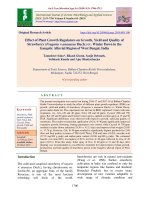
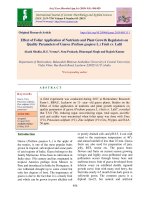
![Effect of different plant growth regulators on shooting of stem cuttings in dragon fruit [Hylocereus undatus (Haworth) Britton & Rose]](https://media.store123doc.com/images/document/2020_01/09/medium_isb1578564896.jpg)
